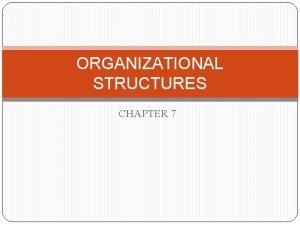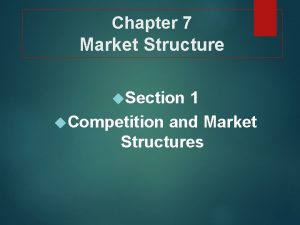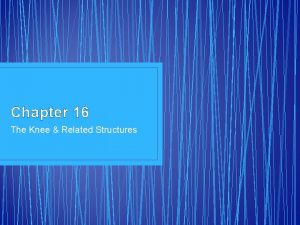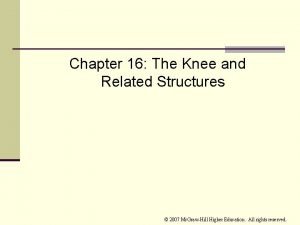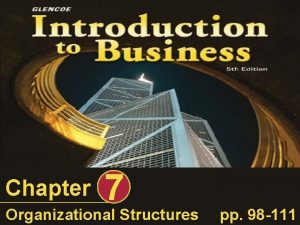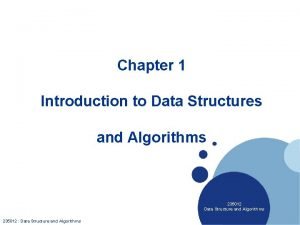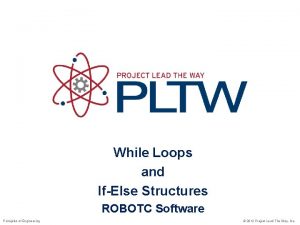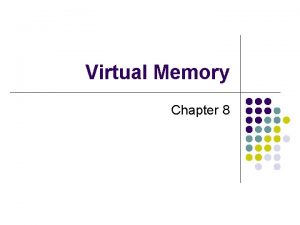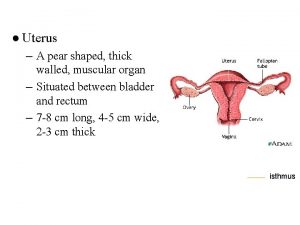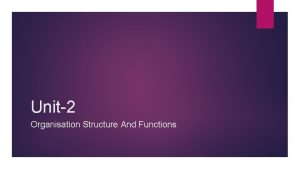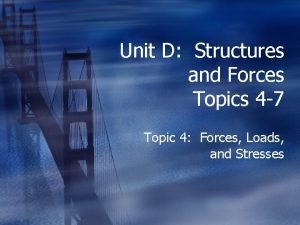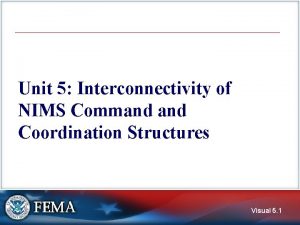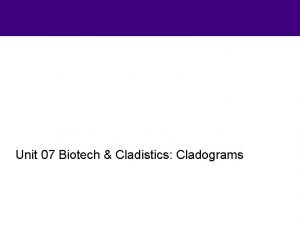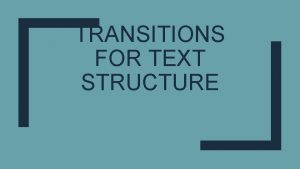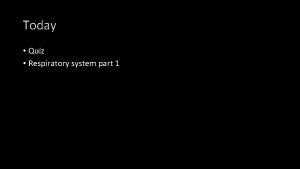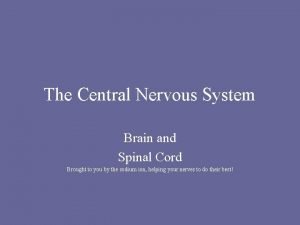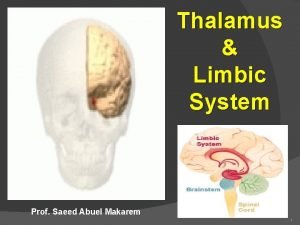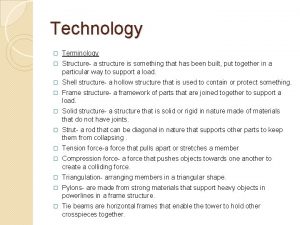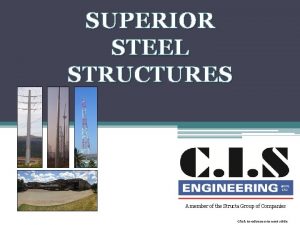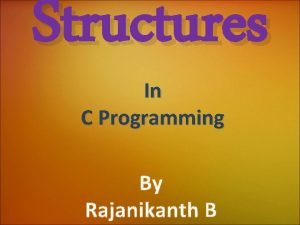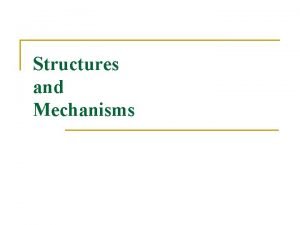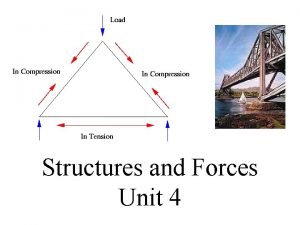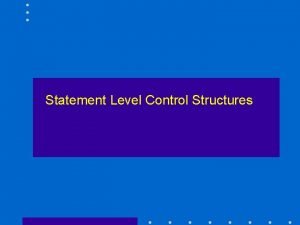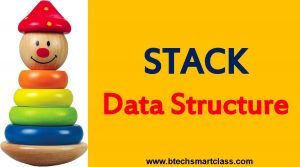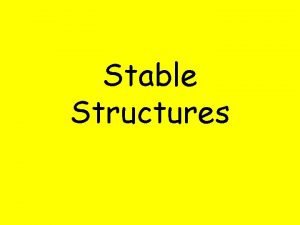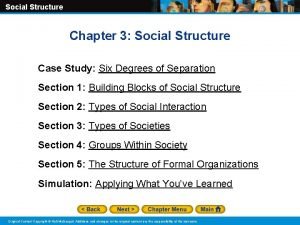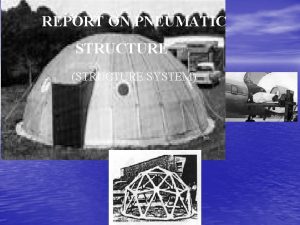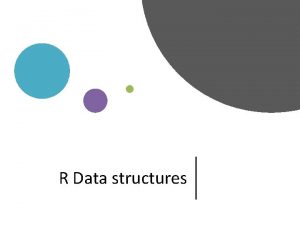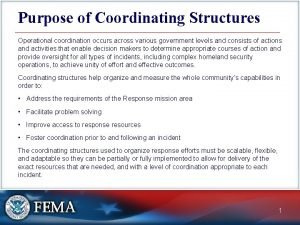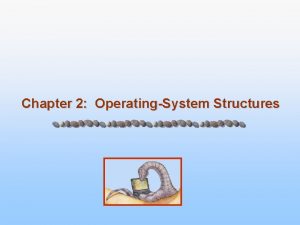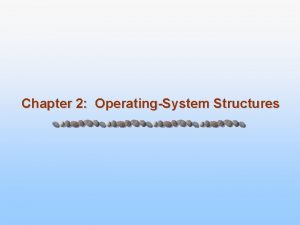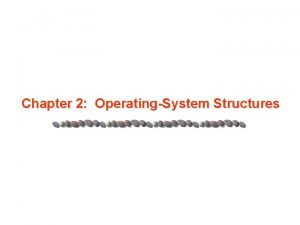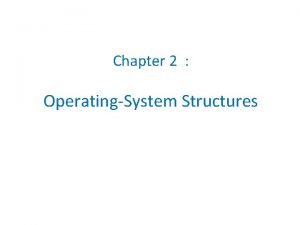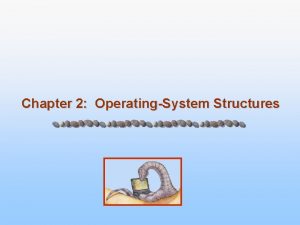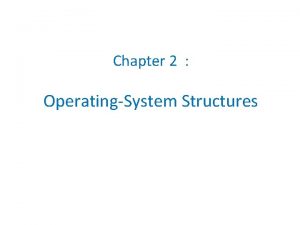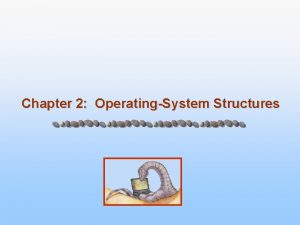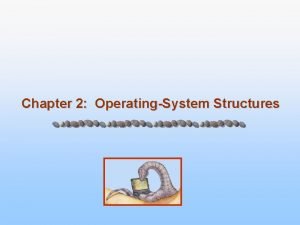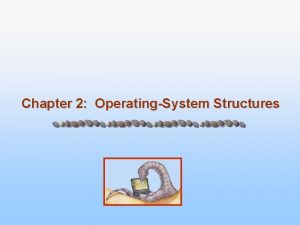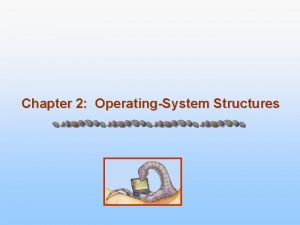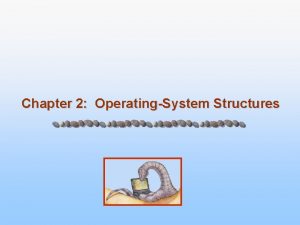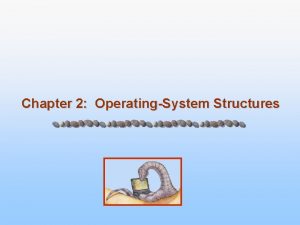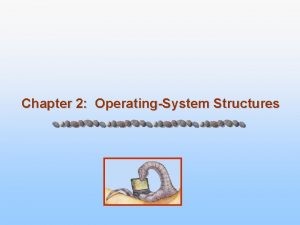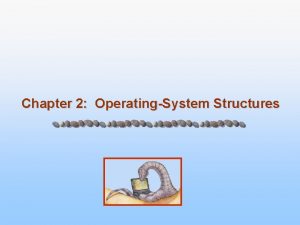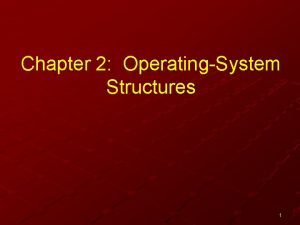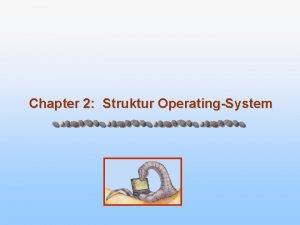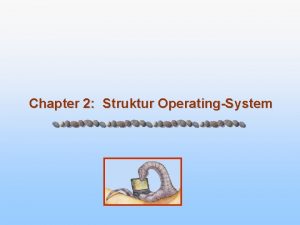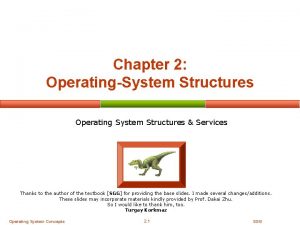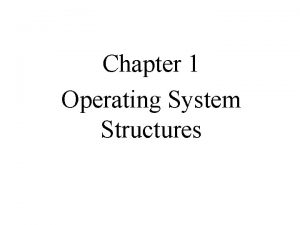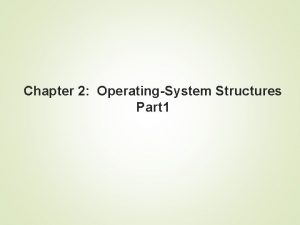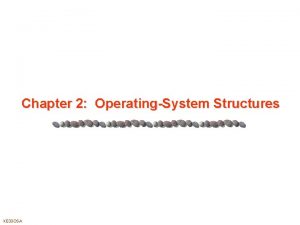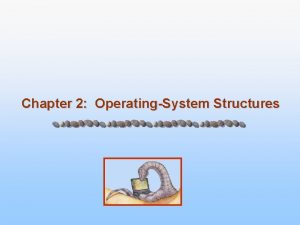Chapter 2 OperatingSystem Structures Chapter 2 OperatingSystem Structures















![Example of System Calls execve(". /a. out", [". /a. out"], [/* 25 vars */]) Example of System Calls execve(". /a. out", [". /a. out"], [/* 25 vars */])](https://slidetodoc.com/presentation_image/43f9371bae48d074315e6f705bfd7a3a/image-16.jpg)





































- Slides: 53

Chapter 2: Operating-System Structures

Chapter 2: Operating-System Structures • • • OS Services The Interface System Calls Types of System Calls System Programs OS Design and Implementation • • OS Structure Virtual Machines OS Generation System Boot

Objectives • To describe the services an operating system provides to users, processes, and other systems • To discuss the various ways of structuring an operating system • To explain how operating systems are installed and customized and how they boot

Operating System Services (an easy-to-use OS) • File-system – Command-Line (CLI), manipulation • User interface Graphics User Interface (GUI), Batch • Program execution – load a program, run that program and execution (normally or abnormally) • I/O operations – Including a file or an I/O device – read/write/create/del ete files and directories – search them – list file Information – permission management

Operating System Services (Cont. ) (an easy-to-use OS) • Communications – on the same computer or between computers – shared memory or through message passing • Error detection – May occur in the CPU and memory hardware, in I/O devices, in user program – OS should take the appropriate action to ensure correct and consistent computing – OS should provide debugging facilities

Operating System Services (Cont. ) (for ensuring the efficient) • Resource allocation – When multiple programs running concurrently, resources must be allocated to each of them • Accounting – To keep track of which users use how much and what kinds of computer resources • Protection and security – Protection • ensuring that all access to system resources is controlled – Security • outsiders requires user authentication • defending external I/O devices from invalid access attempts – A chain is only as strong as its weakest link.

User Operating System Interface - CLI • Sometimes implemented in kernel, sometimes by system programs • Sometimes multiple flavors implemented – shells – Bash, csh… (Unix-like systems) • Primarily fetches a command from user and executes it – Sometimes commands built-in, sometimes just names of programs – If the latter, adding new features doesn’t require shell modification

CLI MS-DOS Busy. Box (for embedded OS)

User Operating System Interface - GUI • User-friendly desktop metaphor interface – Usually mouse, keyboard, and monitor – Icons represent files, programs, actions, etc – Various mouse buttons over objects in the interface cause various actions – Invented at Xerox PARC • Many systems now include both CLI and GUI interfaces – Microsoft Windows – Apple Mac OS X – UNIX is CLI with optional GUI interfaces • Touch programs – HTC & Apple

GUI HTC (Win. CE + “HTC UI”) Apple (Unix + “Apple UI”) G-sensor + touch screen

GUI Tablet PC (without keyboard) Tablet PC (with keyboard)

System Calls • Programming interface to the services provided by the OS – Typically written in a high-level language (C or C++) – Mostly accessed by programs via a high-level Application Program Interface (API) (e. g. , libc) • Three most common APIs – Win 32 API for Windows – POSIX API – Java API • Why use APIs rather than system calls?

Linux 2. 6. 18 (unix-like, POSIX, ~300)

Example of System Calls #include <stdio. h> int main() { printf("hello worldnn"); }

Example of System Calls # gcc test. c --static # strace. /a. out
![Example of System Calls execve a out a out 25 vars Example of System Calls execve(". /a. out", [". /a. out"], [/* 25 vars */])](https://slidetodoc.com/presentation_image/43f9371bae48d074315e6f705bfd7a3a/image-16.jpg)
Example of System Calls execve(". /a. out", [". /a. out"], [/* 25 vars */]) = 0 uname({sys="Linux", node="Lonux-svr", . . . }) = 0 brk(0) = 0 x 8408000 brk(0 x 8408 cb 0) = 0 x 8408 cb 0 set_thread_area({entry_number: -1 -> 6, base_addr: 0 x 8408830, limit: 1048575, seg_32 bit: 1, contents: 0, read_exec_only: 0, limit_in_pages: 1, seg_not_present: 0, useable: 1}) = 0 brk(0 x 8429 cb 0) = 0 x 8429 cb 0 brk(0 x 842 a 000) = 0 x 842 a 000 fstat 64(1, {st_mode=S_IFCHR|0620, st_rdev=makedev(136, 1), . . . }) = 0 mmap 2(NULL, 4096, PROT_READ|PROT_WRITE, MAP_PRIVATE|MAP_ANONYMOUS, -1, 0) = 0 xb 7 fb 5000 write(1, "hello worldn", 12 hello world ) = 12 write(1, "n", 1 ) = 1 exit_group(13) = ?

Example of System Calls # strace -c. /a. out hello world #include <stdio. h> int main() { printf("hello worldnn"); } % time seconds usecs/calls errors syscall ----------- ----------- nan 0. 000000 0 2 write nan 0. 000000 0 1 execve nan 0. 000000 0 4 brk nan 0. 000000 0 1 uname nan 0. 000000 0 1 mmap 2 nan 0. 000000 0 1 fstat 64 nan 0. 000000 0 1 set_thread_area ----------- -----------100. 00 0. 000000 11 total

System Call Implementation • Typically, a number associated with each system call – System-call interface maintains a table indexed according to these numbers • The system call interface invokes intended system call in OS kernel and returns status of the system call and any return values • The caller need know nothing about how the system call is implemented – Just needs to understand what OS will do – Most details of OS interface hidden from programmer by API • printf, scanf, … (libc) for example

API – System Call – OS Relationship Sys call handler jump_table (function pointer array) Return & modechange

System Call Parameter Passing • Often, more information is required than simply identity of desired system call • Three general methods used to pass parameters to the OS – Simplest: pass the parameters in registers – Parameters stored in a block, or table, in memory, and address of block passed as a parameter in a register – Parameters placed, or pushed, onto the stack by the program and popped off the stack by the operating system

Types of System Calls • Process control • File management • Device management • Information maintenance • Communications

MS-DOS execution (a) At system startup (b) running a program

Free. BSD Running Multiple Programs

Solaris 10 dtrace Following System Call

Linux: systemtap http: //sourceware. org/systemtap/getinvolved. html

System programs File manage ment Commu nication s System programs Progra mming support Status informa tion File modific ation

Operating System Design and Implementation • Design and Implementation of OS not “solvable”, but some approaches have proven successful • Internal structure of different Operating Systems can vary widely • Start by defining goals and specifications • Affected by choice of hardware, type of system • User goals and System goals – User goals – operating system should be convenient to use, easy to learn, reliable, safe, and fast – System goals – operating system should be easy to design, implement, and maintain, as well as flexible, reliable, error -free, and efficient

Operating System Design and Implementation (Cont. ) • Important principle to separate Policy: What will be done? Mechanism: How to do it? • Mechanisms determine how to do something, policies decide what will be done • The separation of policy from mechanism is a very important principle, it allows maximum flexibility if policy decisions are to be changed later

Simple Structure • MS-DOS – written to provide the most functionality in the least space – Not divided into modules – Although MS-DOS has some structure, its interfaces and levels of functionality are not well separated

MS-DOS Layer Structure

Layered Approach • The operating system is divided into a number of layers (levels), each built on top of lower layers. The bottom layer (layer 0), is the hardware; the highest (layer N) is the user interface. • With modularity, layers are selected such that each uses functions (operations) and services of only lower-level layers

Layered Operating System

UNIX • UNIX – limited by hardware functionality, the original UNIX operating system had limited structuring. • The UNIX OS consists of two separable parts – Systems programs – The kernel • Consists of everything below the system-call interface and above the physical hardware • Provides the file system, CPU scheduling, memory management, and other operating-system functions; a large number of functions for one level

UNIX System Structure

Microkernel System Structure • Moves as much from the kernel into “user” space • Communication takes place between user modules using message passing • Benefits: – – Easier to extend a microkernel Easier to port the operating system to new architectures More reliable (less code is running in kernel mode) More secure • Detriments: – Performance overhead of user space to kernel space communication

Mac OS X Structure

Modules • Most modern operating systems implement kernel modules – Uses object-oriented approach – Each core component is separate – Each talks to the others over known interfaces – Each is loadable as needed within the kernel • Overall, similar to layers but with more flexible

Solaris Modular Approach

Virtual Machines • A virtual machine takes the layered approach to its logical conclusion. It treats hardware and the operating system kernel as though they were all hardware • A virtual machine provides an interface identical to the underlying bare hardware • The operating system creates the illusion of multiple processes, each executing on its own processor with its own (virtual) memory

Virtual Machines (Cont. ) • The resources of the physical computer are shared to create the virtual machines – CPU scheduling can create the appearance that users have their own processor – Spooling and a file system can provide virtual card readers and virtual line printers – A normal user time-sharing terminal serves as the virtual machine operator’s console

Virtual Machines (Cont. )

Virtual Machines (Cont. ) • The virtual-machine concept provides complete protection of system resources • A virtual-machine system is a perfect vehicle for operating-systems research and development. • The virtual machine concept is difficult to implement due to the effort required to provide an exact duplicate to the underlying machine. (? ? ? )

VMware Architecture Binary translation

x 86 virtualization • Software techniques – Virtualization software (e. g. , VMWare) for the x 86 must employ binary translation techniques to trap and virtualize the execution of certain instructions. – Paravirtualization does not implement the hardto-virtualize parts of the actual x 86 instruction set. • Operating systems are ported to run on the resulting virtual machine

x 86 virtualization • Hardware support – Intel Virtualization Technology (IVT) – AMD virtualization (AMD-V) X 86 Monitor mode

The Java Virtual Machine

Operating System Generation • Operating systems are designed to run on any of a class of machines; the system must be configured for each specific computer site • SYSGEN program obtains information concerning the specific configuration of the hardware system • Booting – starting a computer by loading the kernel • Bootstrap program – code stored in ROM that is able to locate the kernel, load it into memory, and start its execution

System Boot • Operating system must be made available to hardware so hardware can start it – Small piece of code – bootstrap loader, locates the kernel, loads it into memory, and starts it – Sometimes two-step process where boot block at fixed location loads bootstrap loader – When power initialized on system, execution starts at a fixed memory location • Firmware used to hold initial boot code


Virtual machines • Equivalence A program running under the VMM should exhibit a behavior essentially identical to that demonstrated when running on an equivalent machine directly. • Resource control The VMM must be in complete control of the virtualized resources. • Efficiency A statistically dominant fraction of machine instructions must be executed without VMM intervention.

ISA & VM • Privileged instructions – Those that trap if the processor is in user mode and do not trap if it is in system mode. • Control sensitive instructions – Those that attempt to change the configuration of resources in the system. • Behavior sensitive instructions – Those whose behavior or result depends on the configuration of resources (the content of the relocation register or the processor's mode).

ISA & VM Theorem: For any conventional third generation computer, a VMM may be constructed if the set of sensitive instructions for that computer is a subset of the set of privileged instructions.

ISA & VM • critical instructions – sensitive but unprivileged instructions – dynamic recompilation – Paravirtualization • a virtualization technique that presents a software interface to virtual machines that is similar but not identical to that of the underlying hardware
 Homologous structures
Homologous structures Organizing in management
Organizing in management Chapter 7 market structures
Chapter 7 market structures Chapter 7 section 3 structures and organelles
Chapter 7 section 3 structures and organelles Makenzie milton injury
Makenzie milton injury Chapter 16 worksheet the knee and related structures
Chapter 16 worksheet the knee and related structures Chapter 7 organizational structures
Chapter 7 organizational structures Data structures chapter 1
Data structures chapter 1 Chapter 7 market structures vocabulary
Chapter 7 market structures vocabulary Hello market
Hello market Chapter 7 section 3 structures and organelles
Chapter 7 section 3 structures and organelles Gcse computer science wjec
Gcse computer science wjec While loops and if-else structures
While loops and if-else structures Froude number
Froude number Virtualization structures tools and mechanisms
Virtualization structures tools and mechanisms Hardware and control structures
Hardware and control structures Structures piercing cribriform fascia
Structures piercing cribriform fascia Parts of a root
Parts of a root Nerve supply uterus
Nerve supply uterus Bureaucratic structures
Bureaucratic structures Forces on structures grade 5
Forces on structures grade 5 Homologous analogous and vestigial structures
Homologous analogous and vestigial structures Which nims command and coordination structures
Which nims command and coordination structures Analogous structures vs homologous
Analogous structures vs homologous Problem and solution transition words
Problem and solution transition words Respiratory zone structures
Respiratory zone structures The hormone adrenaline can affect only cells with *
The hormone adrenaline can affect only cells with * Branches of common femoral artery
Branches of common femoral artery Accessory structures of female reproductive system
Accessory structures of female reproductive system Social structure examples
Social structure examples Hypothalamus
Hypothalamus Laynx
Laynx Limbic lobe
Limbic lobe Function of the thalamus
Function of the thalamus Text features vs text structures
Text features vs text structures Struts and frame structures
Struts and frame structures Teaching market structures with a competitive gum market
Teaching market structures with a competitive gum market Superior steel structures
Superior steel structures Matrix structure higher business
Matrix structure higher business What are mass structures
What are mass structures Structures in c
Structures in c Circular motion examples
Circular motion examples Natural mass structures
Natural mass structures Statement level control structures
Statement level control structures Btechsmartclasses
Btechsmartclasses Stable structure examples
Stable structure examples Externsic
Externsic Social structures examples
Social structures examples Pneumatic structures
Pneumatic structures Types of data structures in r
Types of data structures in r Draw lewis structures
Draw lewis structures Coordination structures help organize and measure
Coordination structures help organize and measure Sole
Sole What is smile in poetry
What is smile in poetry

